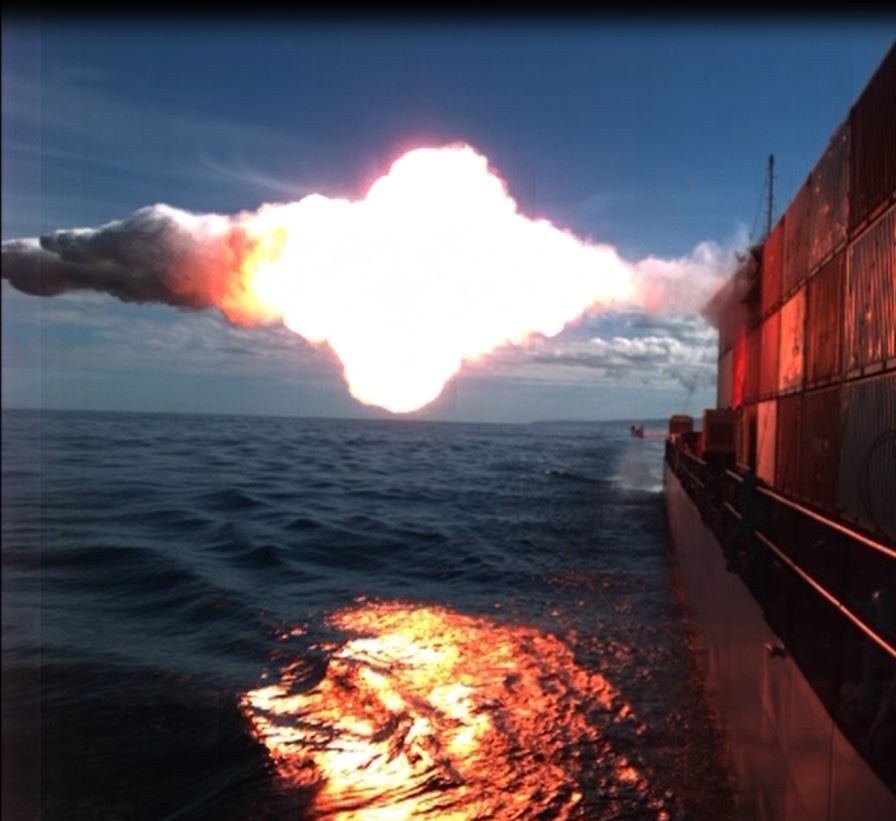
A January test of a Raytheon Tomahawk land attack missile (TLAM) against a moving target at sea could be a short-term answer to the U.S. Navy’s long-range anti-surface missile problem, USNI News understands.
The test – conducted off of San Nicolas Island, Calif. – demonstrated that a TLAM launched from a ship could be guided into a moving target at sea by a Boeing F/A-18E/F Super Hornet.
An unclassified video of the test, obtained by USNI News, shows the missile launch from guided missile destroyer USS Kidd (DDG-100), fly for an unspecified amount of time and punch a hole through a shipping container on a moving ship target and skip across the ocean.
“It demonstrates the viability of long-range communications for position updates of moving targets,” Capt. Joe Mauser, Tomahawk Weapons System (PMA-280) program manager for Naval Air Systems Command (NAVAIR) said in a Feb. 5 Navy statement.
“This success further demonstrates the existing capability of Tomahawk as a netted weapon, and in doing so, extends its reach beyond fixed and re-locatable points to moving targets.”
If the Navy can perfect the methodology, it would give the service an almost 1,000 nautical mile extension – the range of the TLAM — of its lethal anti-surface radius for its newer guided missile destroyers, which are not fitted with the service’s aging RGM-84 Harpoon anti-ship missile.
The Tomahawk Block IV – unlike earlier versions of the missile – has the ability to adjust its flight path based on new information given to the missile allowing it to hit moving targets.
The Navy had briefly fielded a TLAM configured as an ASM the — Tomahawk Anti-Ship Missile (TASM) in the late 1980s.
“[TASM] 200-nautical-mile-plus range was so long that the navy of those days lacked sufficient surveillance assets to guide the TASM to its target,” wrote James Holmes in The Diplomat in 2012.
“Since the bird was subsonic, furthermore, its flight time was so long that the target might move out of the way, foiling the engagement attempt. The navy leadership eventually deemed the danger of hitting friendly or neutral vessels unacceptable.”
Most of the TASMs were converted into land attack Tomahawks in the early 1990s.
The testing of the Block IV Tomahawk as an ASM falls in line with the call U.S. surface leadership made to beef up the deadly force on surface ships in a plan called, distributed lethality.
“If I need a new weapon system, I don’t go spend ten years developing it,” the service’s director of surface warfare Rear Adm. Peter Fanta said in January.
“I go take a seeker – if that’s my problem – and I glue it on the front end of an existing missile. If it doesn’t go far enough, I put a new backend on it. If someone around the world is already flying it, I go buy it.”
However, the service may have to include a new seeker on the Block-IV to make it effective and its unclear what other information, surveillance and reconnaissance (ISR) assets could guide the missile to its final target.
Still, the Block IV could be a quick fix to the Navy’s ASM gap before new capabilities like the Long Range Anti-Ship Missile (LARSM) come online.





